Community Internet WiFi
Many rural and remote communities around the world often lack basic infrastructure, and telecommunications services are low on the list. Although many people in these communities have mobile phones they may have to travel to a nearby town to get a connection to the network.
For the past several years some communities have installed an Internet service with a satellite connection and controlling and selling the WiFi Internet access using Guest Internet controller products. People who know how to use a computer can install the WiFi Internet service for a community; no special skills are required. However there are limitations for the installation and that is the subject of this article.
Communication distance
The most common question we get is how far can the WiFi antenna communicate. There are some rules with the design of the WiFi wireless equipment and some rules about the location of the WiFi antenna.
- Wireless equipment design; WiFi equipment has a limited power output and the maximum power is set by the FCC and other government regulatory organizations. The maximum power of a WiFi antenna is less than one hundredth of a mobile phone antenna. This limited power output determines the maximum transmission range. The more powerful mobile phone antenna can transmit much further then a WiFi antenna.
- Wireless equipment location; The WiFi signal is blocked by walls and trees so it is very important that the WiFi antenna in installed on a high point, the roof of a building or on a tower so that the antenna is visible to the people who want to connect to the WiFi service. This is called line of sight visibility.
The frequency of operation is also a factor for the maximum distance of transmission. The WiFi antenna transmits a radio frequency signal that is in a shared band, either 2.4 GHz or 5.8 GHz. Many other WiFi products are also transmitting in the same band which causes interference. When the interference is greater, the maximum distance is shorter. A WiFi antenna in an urban area has a shorter range of communication than a WiFi antenna in a remote rural area that has no interference. By comparison, mobile phone antennas can transmit further because they use exclusive frequencies that are purchased by the mobile phone company so there is no interference.
The receiving devices
The people who want access to the Internet connect to the WiFi antenna in one of two ways.
- A mobile phone WiFi connection to the WiFi antenna.
- A home antenna connection to the WiFi antenna.
The method that the person uses also determines the maximum distance of communication, as we will see in the following sections.
Connecting mobile phones to a WiFi antenna
A mobile phone has three limitations when connecting over a long distance to a WiFi antenna.
- The power output of the transmitter is low.
- The sensitivity of the receiver is low.
- The WiFi antenna in the phone gives a poor signal as it has to work in any orientation when the phone user is moving.
With the WiFi antenna installed at a high point with clear line of sight to the mobile phone the maximum distance is typically 100m. This might be further if the WiFi transmitter has a direction antenna and the phone has the best specification but the distance will not exceed 200m.
The next diagram shows the typical maximum distance between a WiFi antenna and a mobile phone.
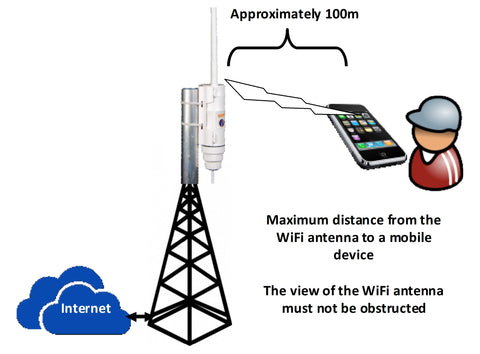
Connecting a home to a WiFi antenna
A home will have a directional antenna and radio installed on the roof with a direct line of sight to the central WiFi antenna. The antenna on the roof connects to a wireless router inside the home. The home residents connect to the wireless router to get Internet access.
The directional antenna and radio installed on the home roof has much better WiFi characteristics when compared with a mobile phone;
- The transmitter power is higher.
- The receiver has great sensitivity.
- The antenna is directional with a high gain.
The directional antenna and radio installed on a home roof can communicate ten times further than a mobile phone can to a central WiFi antenna.
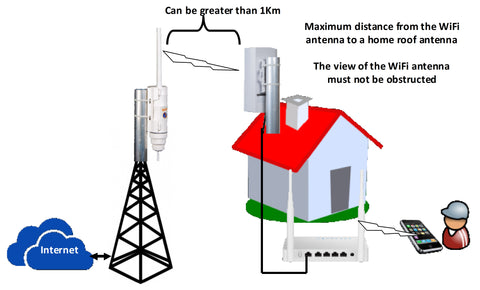
Connecting mobile phones at a further distance from the Internet connection
It is possible to provide a connection for mobile phones more then 1 Km away from the Internet connection. This is done using a point-to-point wireless link. One end for the wireless link (the Host) connects to the Internet; the other end of the wireless link connects to a wireless access point that broadcasts a signal for mobile phones.
The distance that the point-to-point link communicates can be greater than 1Km however there must be line of sight between the antennas any obstruction will block the signal.
One point-to-point link can provide an Internet connection for 10 to 15 people, possibly more. Several point-to-point links can be installed in a community to provide WiFi Internet for mobile phones over a larger area.

What type of Internet connection can be used?
A community can use any type of Internet connection, however it is essential to have a service with a high data speed, the speed is measured in Mb/s. Some typical Internet connections are listed below.
- ADSL: data speed of 10Mb/s to 20Mb/s.
- Fiber: data speed of 100Mb/s to 1000Mb/s.
- Geo-stationary satellite (HughesNet): 20Mb/s to 100Mb/s.
- Low earth orbit (LEO) satellite (Starlink): 100mb/s to 200Mb/s.
A service such as ADSL or fiber requires a cable that connects the community to a central hub provided by the telephone company, called the Internet Service Provider (ISP). Very few remote rural communities have this type of service and so the only option for many communities is to use a satellite service. The Starlink service has global coverage and can be used in countries that have an agreement with Starlink to operate the service.
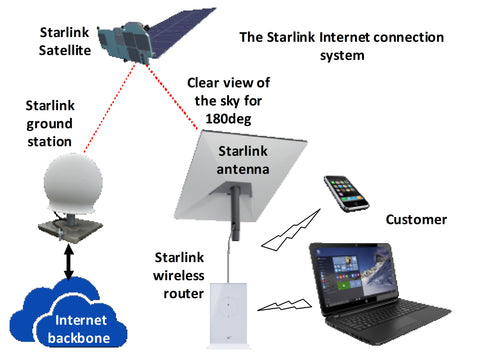
The Starlink service has several data plans available; each plan has a maximum speed. The basic residential plan should maintain less then 1TB per month of data use. There are plans that permit a high volume of data to be transferred for an additional fee. The community should evaluate which Starlink plan best meets the needs of the community.
The Starlink terms of service do place some restrictions on the use of the service. Excessive use by causing network congestion due to many people connecting to the service causing consistent high volume data use might be considered a breach of the terms of service and Starlink may suspend the service to that antenna.
Using Starlink to provide an Internet service for a community with STAR kits
When a Starlink antenna provides a service for many homes then network congestion may occur due to excessive data volume. It is therefore necessary to manage the community Starlink service so that the community members can enjoy the Internet service without concern that the service may be interrupted due to abuse. Guest Internet controllers have been installed by many communities to share Starlink and other satellite services because they are very easy to install and use. The Guest Internet controller provides rules for Internet access so that the Starlink service can be shared by many people. All Internet services set rules for maximum data speed and data volume.

How can the community control and sell the Internet access?
Guest Internet controllers manage the WiFi Internet service for a community by imposing rules on individual use so that each person gets a good Internet connection, plus ensuring the Starlink service is not abused. Each person that wants to connect to the Internet service is given an access code that determines how that person can use the service, the access code has the following parameters;
- The length of time that the person can remain connected to the Internet, or the user can be connected permanently.
- The maximum download and upload data speeds.
- The maximum download and upload data byte count permitted.
- The maximum number of people who can use the code, usually 1.
- Optionally blocking services like Torrent that might be used to share copyrighted files.
- Optionally blocking services that require a consistently high bandwidth.
Each member of the community receives or purchases an access code that provides access to the Internet for a period of time with the data speed and data limits assigned to the code. The access time starts counting after the first use and once the code time has been used the code is deleted from the controller. The access codes are printed onto vouchers using the Guest Internet software. The voucher design is customized by the person providing the service, adding a logo and text to the voucher design. A voucher is shown in the figure.
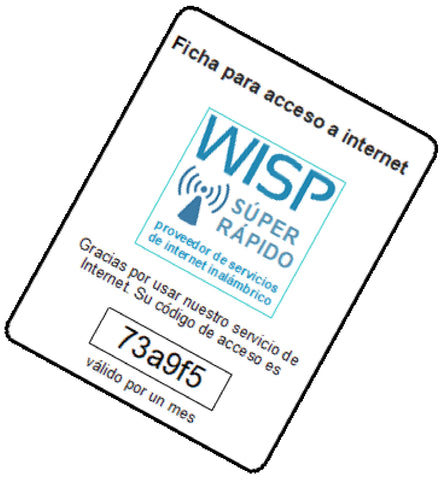
The vouchers are printed using a computer with a letter size printer. Sixteen vouchers are printed on each sheet of paper and up to 10,000 vouchers can be printed at one time. The Guest Internet software makes voucher printing very easy. This is shown in the figure.
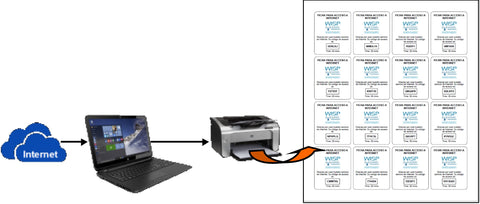
How many people can connect to the Internet service?
The number of people that can connect to an Internet service depends on two factors;
- The data speed of the Internet service in Mb/s.
- The maximum data speed allowed for each user.
Sharing one Internet connection between many people is simple math.
For example, the Internet service has a speed of 100Mb/s. The maximum speed for each user is set at 5Mb/s. The number of people that can connect to the service is 100/5 = 20 people. We can connect more people because not everyone will be using the Internet at the same time so this number can be increased to 30.
With an Internet service of 200Mb/s and a maximum speed per user of 2Mb/s we can connect 200/2 = 100 people.
We can increase the number of users by putting a time limit on each user.
We have to take care that the Internet service data volume is not exceeded and so we should put data limits on each user of the Internet service.
For more information about the STAR kits please visit the Guest Internet and Wispzone websites to download data sheets.


1 comment
Eteily Technologies
Great article!
Wi-Fi antennas play a vital role in enhancing wireless coverage, signal stability, and data throughput across modern networks. Factors such as antenna gain, radiation pattern, and placement significantly impact overall Wi-Fi performance, especially in high-density and industrial environments.
At Eteily Technologies, we design and manufacture reliable Wi-Fi antennas including rubber duck, paddle, and high-gain outdoor models. Our antennas are optimized for 2.4 GHz, 5 GHz, and dual-band applications, helping deliver stronger connections and improved network efficiency.
Thanks for sharing such useful insights—this is very helpful for anyone working with wireless networking solutions 📶